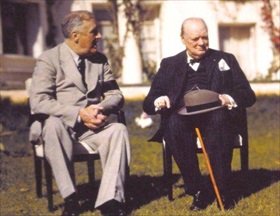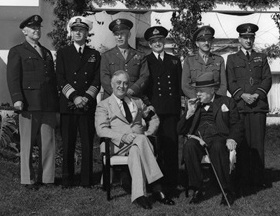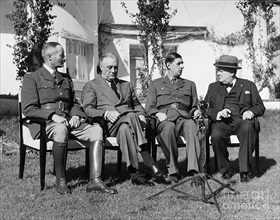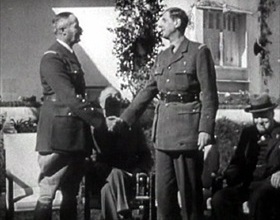ROOSEVELT, CHURCHILL PLOT NEXT PHASE OF WAR
Casablanca, Morocco, North Africa · January 14, 1943
This date in 1943 saw the start of the ten-day Casablanca Conference at a seaside resort in Morocco between U.S. President Franklin D. Roosevelt, British Prime Minister Winston Churchill, and their Combined Chiefs of Staff. Soviet leader Joseph Stalin had been invited to the summit but reportedly told Roosevelt’s closest adviser that he had no time for small talk, preoccupied as he was with the battle for the possession of Stalingrad (today’s Volgograd) on Germany’s Eastern Front. Aside from an excursion to Marrakesh, the two Western leaders were all business. For one thing, they agreed on a combined bomber offensive against Germany that incorporated the newly deployed U.S. Eighth Air Force in Britain. The U.S. would use precision bombing by day, the British area bombing by night. Furthermore, the leaders insisted on nothing less than unconditional surrender by the three major Axis powers: Germany, Italy, and Japan. Churchill initially feared that insisting on unconditional surrender would prolong Germany’s willingness to fight on and discourage those elements opposed to Hitler within the German armed forces, but the prime minister’s own cabinet was on board with the concept of unconditional surrender. Later in 1943 the U.S., Britain, and the Soviet Union established the European Advisory Commission to draw up surrender terms for Germany and work out occupation arrangements for Germany and Austria and the minor Axis players like Romania, Hungary, and Bulgaria. These plans were agreed to by the three heads of government at the Yalta and Potsdam conferences in 1945. Casablanca also saw Roosevelt and Churchill agree to punish Nazi war criminals. (The principle of postwar war crimes trials had been established by the leaders of nine occupied European nations and China at the Inter-Allied Conference in London twelve months earlier.) In the Potsdam Declaration, issued on July 26, 1945, from a Berlin suburb, the Allied heads of state extended the principle to include Japan, whose leaders were fighting a losing war in the Pacific. The decision at Potsdam resulted in two sets of major international war crimes trials, one held in Nuremberg, Germany, and the other in Tokyo, in which some of the most senior Axis figures were tried. The charges at their trials included two new concepts in international law: crimes against peace and crimes against humanity.
[amazon_carousel widget_type=”ASINList” width=”600″ height=”200″ title=”Recommended Reading” market_place=”US” shuffle_products=”False” show_border=”False” asin=”1780393970,0807855073,0700612262,0061228583,0340720271,0801846978,1566634849,0812972821,0743244540,1403979650″ /]
Casablanca 1943: Anglo-American Summit Meeting Between Roosevelt and Churchill
 |  |
Left: The Casablanca Conference, codenamed Symbol (January 14–24, 1943), was a secret meeting of U.S. President Franklin D. Roosevelt, British Prime Minister Winston Churchill, and their military operations and planning staff (known as the Combined Chiefs of Staff) to advise on Allied strategy for the next phase of the war in Europe. The first of the great Allied mid-war conferences, the conference agenda addressed the specifics of tactical procedure, allocation of resources, and the broader issues of diplomatic policy. The debate and negotiations produced what was known as the “Casablanca Declaration,” and what is perhaps its most historically provocative statement of purpose, “unconditional surrender” of the Axis powers along with their criminal leaders. Roosevelt had borrowed the term “unconditional surrender” from U.S. Civil War hero Gen. Ulysses S. Grant, explaining to a radio audience in February 1943: “In our uncompromising policy we mean no harm to the common people of the Axis nations. But we do mean to impose punishment and retribution upon their guilty, barbaric leaders.”
![]()
Right: Roosevelt and Churchill seated in front of a full complement of Allied admirals, generals, and field marshals in the garden of the Anfa Hotel in Casablanca, January 1943. Standing, front row, left to right: Commanding General of the U.S. Army Air Forces Henry “Hap” Arnold; Commander in Chief, United States Fleet and Chief of Naval Operations Admiral Ernest King; U.S. Army Chief of Staff Gen. George Marshall; British Admiral of the Fleet Sir Dudley Pound; British Air Chief Marshal Charles Portal; and Gen. (later Field Marshal) Alan Brooke. Gen. Arnold continued the Casablanca discussions in Chungking, China, with Generalissimo Chiang Kai-shek, which resulted in definite plans for offensive operations in the Pacific Theater.
 |  |
Above: Leaders of the Free French forces Generals Henri Giraud (left) and Charles de Gaulle at the Casablanca Conference. In the wake of the initial success of Operation Torch, which eventually resulted in the defeat of Vichy French forces in North Africa, Roosevelt and Churchill called for the official recognition of a joint leadership of the Free French forces, notwithstanding the notable tension between the two Frenchmen during the talks. Roosevelt and Churchill used their considerable powers of persuasion to have the two French generals “make nice” to each other, even staging this photo-op on January 17, 1943, to demonstrate public cordiality between them. It lasted through just two handshakes.
Newsreel Scenes From the Casablanca Conference, January 14–24, 1943
![]()

 History buffs, there is good news! The Daily Chronicles of World War II is now available as an ebook for $4.99 on Amazon.com. Containing a year’s worth of dated entries from this website, the ebook brings the story of this tumultuous era to life in a compelling, authoritative, and succinct manner. Featuring inventive navigation aids, the ebook enables readers to instantly move forward or backward by month and date to different dated entries. Simple and elegant! Click
History buffs, there is good news! The Daily Chronicles of World War II is now available as an ebook for $4.99 on Amazon.com. Containing a year’s worth of dated entries from this website, the ebook brings the story of this tumultuous era to life in a compelling, authoritative, and succinct manner. Featuring inventive navigation aids, the ebook enables readers to instantly move forward or backward by month and date to different dated entries. Simple and elegant! Click 











